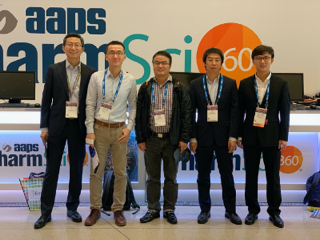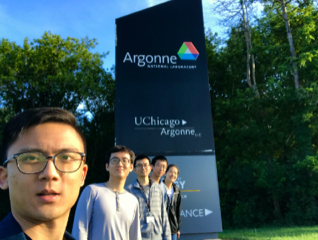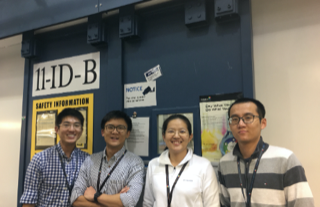Zhenxuan Chen recognized for innovative research in understanding the structure of molecular glasses
By Stephanie Blaszczyk
Over 1,000 abstracts were submitted to the 2019 American Association of Pharmaceutical Scientists (AAPS) PharmSci360 Conference in San Antonio, Texas. Zhenxuan Chen, a fourth-year doctoral student in UW–Madison School of Pharmacy’s Pharmaceuticals Sciences PhD program, was recognized with a Best Abstract Award for his research’s innovation and importance to pharmaceutical sciences.
Chen’s Best Abstract Award means that his research scored in the top 10 percent of all submissions — which is no small feat. Abstracts are submitted by graduate students, postdoctoral candidates, primary investigators with fewer than three years in academia, and early-career industrial scientists with fewer than three years in industry.
“The most exciting research is being recognized during the meeting,” says Me’Gesha Portlock, awards and fellows coordinator for AAPS. “The judges are looking to see if the conclusion of the poster is data driven and if the author’s selected strategy for evaluating the hypothesis suits the process. They’re also asking whether or not the viewers will find the poster novel or exciting and whether the research advances its field.”
Chen, who works as a member of the Yu Lab with Professor Lian Yu in the School of Pharmacy, studies how to control the structure of glass-like substances known as amorphous solids.

Zhenxuan Chen (far right) with former and
current members of the Yu Lab group
Most people are familiar with crystalline solids, such as table salt or sugar. The crystal shape is a physical manifestation of the substance’s microscopic structure, which results from the arrangement of atoms into a highly ordered, repeating pattern that’s held together by intermolecular forces. Amorphous solids, on the other hand, have local order but lack this repeating pattern.
“Amorphous solids are usually made by heating a substance above its melting point, then rapidly cooling to low temperature,” says Chen. “During the cooling process, the liquid becomes the solid, but there’s no long-range order that is characteristic in the crystalline materials.”
But this total molecular disorder is not a total loss for researchers.
“Amorphous solids have order that can be created,” says Yu. “The goal of this research is to introduce order into amorphous materials to improve their functionality.”
In concrete terms, improved functionality would result from a more stable amorphous solid, or a stronger glass, which is attractive to both the pharmaceutical and technological industries.
“Chen has the creativity to come up with new ideas — something that can’t be taught.” —Professor Lian Yu
In the pharmaceutical industry, drugs in their amorphous form demonstrate enhanced solubility in comparison to their crystalline counterparts.
“Drug solubility is important for oral drug products,” says Chen. “Most drugs are hydrophobic, meaning they are repelled from water, but once they’re ingested, they go to the aqueous environment of the stomach. If the drug has poor solubility in the stomach, then the absorption will be poor.”
However, using better amorphous materials for drug delivery can alleviate the absorption issues by enhancing the solubility of a particular drug. For example, Chen mentions that the drug Ritonavir, which is an FDA-approved drug for the treatment of HIV, has poor solubility in the crystalline form, but when made into an amorphous form, the intrinsic dissolution rate increases tenfold. Additionally, some amorphous drugs can only stay in the amorphous phase for several months, so the prescription’s shelf-life is limited, but a more stable solid could prolong the expiration date.


Chen uses X-ray scattering to gather information about the structure, chemical composition, and the physical properties of a particular sample. X-ray scattering is a non-destructive process that determines the structure of crystalline or amorphous materials by solving the density of the negatively charged particles, known as electrons, in a sample. The electrons cause the incident X-rays to scatter, and the intensity and pattern that results from the scattered X-rays can be deconvoluted through mathematical manipulations.
“If we want to create order, then we need a better understanding of the property-structure relationship of amorphous solids,” says Chen. “X-ray scattering can help us obtain this fundamental understanding.”
Chen credits the guidance from Professor Yu as a significant contributor to his success.
“He’s a very good scientist and an expert in amorphous solids,” says Chen. “He guides us in selecting a research direction that includes basic science but is also helpful to the pharmaceutical industry.”
And as the Pharmaceutical Sciences PhD program continues to grow, it’s more important than ever that knowledge is passed down not only from the professors to their students, but also from one group member to another. Yu recognizes the value of graduate students like Chen — as both a scientist and a leader.
“Zhenxuan exhibits all of the elements needed to be a successful graduate student,” says Yu. “He learns well in the classroom, doing coursework, but he also has the creativity to come up with new ideas — something that can’t be taught.”
But just thinking of new ideas isn’t enough. Yu explains that Chen can take a new idea and “reduce it down to the lab level”, meaning he can design the experiments needed to see if it’s feasible.
Much of Chen’s lab work uses state-of-the-art instrumentation at Argonne National Laboratory located outside of Chicago, and Yu admits that it can be a grueling 48-72 hours when Chen and other group members travel to Argonne because they want to run as many experiments as they can in their allotted time.
“It takes a significant amount of preparation beforehand, and Zhenxuan is instrumental in promoting the success of the group in these cases. He’s not only planning and completing his own experiments, but he’s teaching others to make sure theirs run smoothly,” says Yu.
“You hope that a student will become a leader in their senior years, and Zhenxuan is playing that role.”